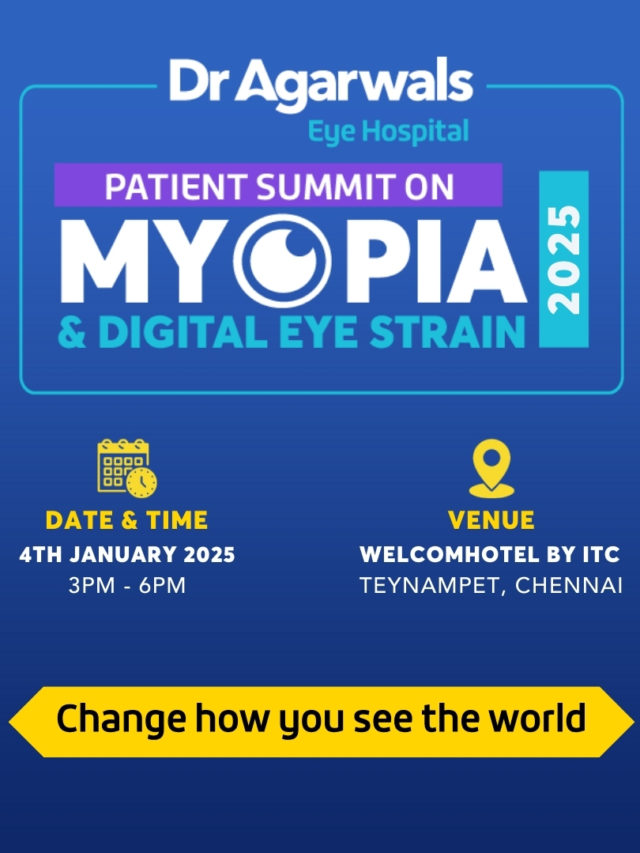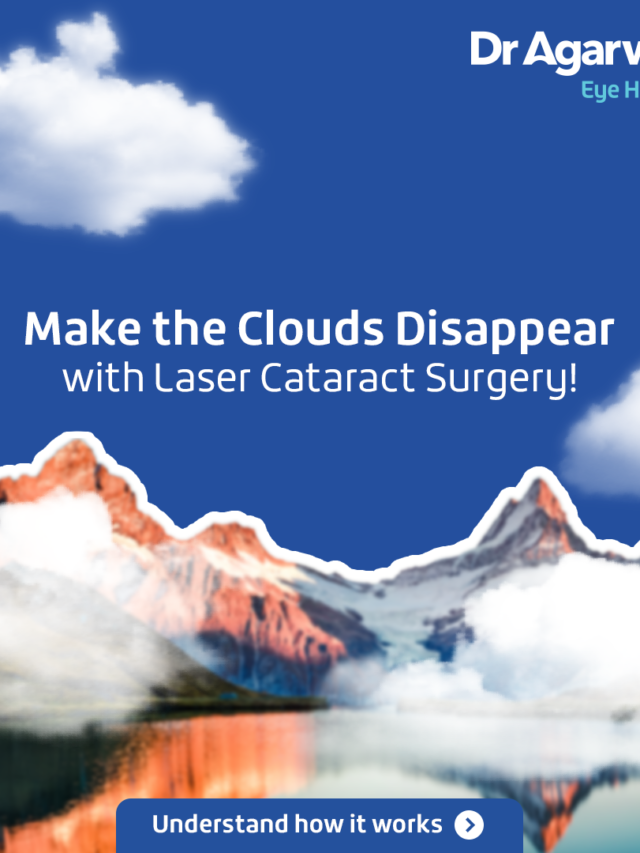मोतीबिंदू ही डोळ्यांची एक सामान्य समस्या आहे जी जगभरातील लाखो लोकांना प्रभावित करते, विशेषतः वयानुसार. डोळ्याच्या नैसर्गिक लेन्सच्या ढगाळपणामुळे दृष्टी अंधुक होऊ शकते, प्रकाशाची संवेदनशीलता वाढू शकते आणि रात्री पाहण्यास त्रास होऊ शकतो, ज्यामुळे शेवटी दैनंदिन कामांवर परिणाम होतो. सुदैवाने, मोतीबिंदूवर उपचार करता येतात आणि या स्थितीचे व्यवस्थापन करण्यासाठी विविध पर्याय उपलब्ध आहेत, तसेच जीवनशैलीत बदल केल्याने डोळ्यांचे आरोग्य सुधारू शकते.
या ब्लॉगमध्ये, आपण मोतीबिंदूवरील उपचार पर्याय, या स्थितीचे व्यवस्थापन करण्यासाठी जीवनशैलीतील बदल आणि तुमची दृष्टी कशी सुरक्षित ठेवावी याबद्दल चर्चा करू.
मोतीबिंदू म्हणजे काय?
मोतीबिंदू डोळ्याच्या लेन्समधील प्रथिने तुटतात तेव्हा उद्भवतात, ज्यामुळे ढगाळ किंवा अंधुक दृष्टी येते. मोतीबिंदू बहुतेकदा वयाशी संबंधित असतात, परंतु ते मधुमेह, अल्ट्राव्हायोलेट (यूव्ही) प्रकाशाच्या दीर्घकाळ संपर्कात राहणे, धूम्रपान करणे किंवा डोळ्यांना झालेल्या दुखापतींमुळे देखील होऊ शकतात. मोतीबिंदू हळूहळू विकसित होतात, बहुतेकदा दोन्ही डोळ्यांमध्ये, आणि उपचार न केल्यास त्यांचे परिणाम कालांतराने खराब होऊ शकतात.
मोतीबिंदूची प्रमुख लक्षणे:
-
धूसर किंवा ढगाळ दृष्टी
-
प्रकाशाची संवेदनशीलता, विशेषतः रात्री
-
दिवेभोवती हेलोस
-
फिकट किंवा पिवळे रंग
-
तपशील वाचण्यात किंवा पाहण्यात अडचण येणे
मोतीबिंदूचे प्रभावीपणे व्यवस्थापन करण्यासाठी लवकर निदान होणे महत्त्वाचे आहे, ज्यामुळे व्यक्तींना त्यांच्या दृष्टीवर गंभीर परिणाम होण्यापूर्वी उपचार पर्यायांचा शोध घेता येतो.
मोतीबिंदू साठी उपचार पर्याय
मोतीबिंदू उपचार स्थितीच्या टप्प्यावर आणि तुमच्या दैनंदिन जीवनावर त्याचा कसा परिणाम होतो यावर अवलंबून असते. येथे सर्वात सामान्य उपचार पर्याय आहेत:
१. प्रिस्क्रिप्शन चष्मा आणि व्हिज्युअल एड्स
मोतीबिंदूच्या सुरुवातीच्या टप्प्यात, दृष्टी बदल सौम्य असू शकतात. अशा प्रकरणांमध्ये, प्रिस्क्रिप्शन चष्मा किंवा कॉन्टॅक्ट लेन्स स्पष्टता सुधारून लक्षणे व्यवस्थापित करण्यास मदत करू शकतात. अँटी-ग्लेअर कोटिंग्ज किंवा मॅग्निफायिंग लेन्स देखील प्रकाशाच्या संवेदनशीलतेचा प्रभाव कमी करण्यास आणि कमी प्रकाशाच्या परिस्थितीत दृष्टी सुधारण्यास मदत करू शकतात.
हा पर्याय कधी विचारात घ्यावा: जर मोतीबिंदू लवकर आढळला आणि तुमच्या दैनंदिन कामांमध्ये लक्षणीय अडथळा आणत नसेल, तर काही काळासाठी सुधारात्मक लेन्स पुरेसे असू शकतात. तथापि, हा एक तात्पुरता उपाय आहे, कारण मोतीबिंदू वाढतच राहील.
२. मोतीबिंदू शस्त्रक्रिया
मोतीबिंदू काढून टाकण्यासाठी आणि स्पष्ट दृष्टी पुनर्संचयित करण्यासाठी शस्त्रक्रिया हा एकमेव निश्चित उपचार आहे. प्रक्रियेदरम्यान, ढगाळ लेन्स काढून टाकला जातो आणि त्याऐवजी स्पष्ट, कृत्रिम इंट्राओक्युलर लेन्स (IOL) लावला जातो. अनेक प्रकारचे IOL उपलब्ध आहेत, ज्यात मानक मोनोफोकल लेन्स (जे एका अंतरासाठी दृष्टी सुधारतात) आणि मल्टीफोकल किंवा अकोमोडेटिंग लेन्स (जे अनेक अंतरांवर दृष्टी सुधारतात) यांचा समावेश आहे.
मोतीबिंदू शस्त्रक्रिया हे सामान्यतः जलद, सुरक्षित आणि बाह्यरुग्ण तत्वावर केले जाते. पुनर्प्राप्तीचा कालावधी कमी असतो आणि शस्त्रक्रियेनंतर जवळजवळ लगेचच अनेकांना दृष्टी सुधारल्याचे दिसून येते.
हा पर्याय कधी विचारात घ्यावा: जर मोतीबिंदू तुमच्या दैनंदिन जीवनात व्यत्यय आणू लागला - जसे की गाडी चालवणे, वाचणे किंवा टीव्ही पाहणे - तर शस्त्रक्रियेबद्दल नेत्ररोग तज्ञाचा सल्ला घेण्याची वेळ आली आहे.
३. लेसर-सहाय्यित मोतीबिंदू शस्त्रक्रिया
मोतीबिंदू शस्त्रक्रियेच्या एका प्रगत प्रकारात लेसरचा वापर करून अचूक चीरे काढली जातात आणि मोतीबिंदू काढून टाकण्यापूर्वी तो मऊ केला जातो. ही पद्धत अधिक अचूकता प्रदान करते आणि पुनर्प्राप्ती वेळ कमी करू शकते.
दृष्टिवैषम्य सारख्या विशिष्ट डोळ्यांच्या आजार असलेल्या किंवा उपलब्ध असलेल्या सर्वात अचूक उपचार पर्यायाची इच्छा असलेल्या व्यक्तींसाठी लेसर-सहाय्यित मोतीबिंदू शस्त्रक्रिया करण्याची शिफारस केली जाते.
हा पर्याय कधी विचारात घ्यावा: जर तुम्हाला दृष्टिवैषम्य असेल किंवा मोतीबिंदू काढून टाकण्यासाठी अधिक प्रगत शस्त्रक्रिया तंत्र पसंत असेल, तर लेसर-सहाय्यित शस्त्रक्रिया हा एक उत्तम पर्याय असू शकतो.
४. शस्त्रक्रियेनंतरची काळजी आणि दृष्टी पुनर्वसन
शस्त्रक्रियेनंतर, अनेक रुग्णांना दृष्टीमध्ये लक्षणीय सुधारणा दिसून येतात. तथापि, योग्य उपचार सुनिश्चित करण्यासाठी आणि दीर्घकालीन डोळ्यांचे आरोग्य राखण्यासाठी नियमित फॉलो-अप काळजी घेणे आवश्यक आहे. दृष्टी पुनर्वसन सेवा रुग्णांना कोणत्याही अवशिष्ट दृष्टी बदलांशी जुळवून घेण्यास मदत करू शकतात.
हा पर्याय कधी विचारात घ्यावा: शस्त्रक्रियेनंतर, तुमच्या डॉक्टरांना नियमित भेटी देणे डोळ्याचे डॉक्टर पुनर्प्राप्तीसाठी आणि इष्टतम परिणाम सुनिश्चित करण्यासाठी हे अत्यंत महत्वाचे आहे.
मोतीबिंदू व्यवस्थापित करण्यासाठी जीवनशैलीतील समायोजने
मोतीबिंदू शस्त्रक्रिया ही एक अत्यंत प्रभावी उपचारपद्धती असली तरी, जीवनशैलीत काही बदल केल्याने तुमची दृष्टी सुरक्षित राहू शकते आणि मोतीबिंदूची प्रगती कमी होऊ शकते. येथे काही महत्त्वाचे टप्पे दिले आहेत:
१. अतिनील किरणांपासून तुमचे डोळे वाचवा
अतिनील (UV) प्रकाशाच्या जास्त संपर्कामुळे मोतीबिंदूचा विकास जलद होऊ शकतो. बाहेर पडताना 100% अतिनील किरणांना रोखणारे सनग्लासेस घालल्याने तुमच्या डोळ्यांचे नुकसान होण्यापासून संरक्षण होऊ शकते. याव्यतिरिक्त, रुंद काठाची टोपी घालल्याने तुमच्या डोळ्यांना अतिरिक्त सावली मिळू शकते.
२. दीर्घकालीन आरोग्य स्थिती व्यवस्थापित करा
मधुमेहासारख्या दीर्घकालीन आजारांमुळे मोतीबिंदूचा धोका वाढू शकतो, म्हणून तुमच्या एकूण आरोग्याचे व्यवस्थापन करणे आवश्यक आहे. रक्तातील साखरेची पातळी नियंत्रणात ठेवा, कोणत्याही दीर्घकालीन आजाराचे व्यवस्थापन करण्यासाठी तुमच्या डॉक्टरांच्या सल्ल्याचे पालन करा आणि तुमच्या दृष्टीचे रक्षण करण्यासाठी एकूण आरोग्याला प्राधान्य द्या.
३. धूम्रपान सोडा
धूम्रपानामुळे मोतीबिंदू होण्याचा धोका वाढतो असे मानले जाते. धूम्रपान सोडल्याने मोतीबिंदू होण्याची शक्यता लक्षणीयरीत्या कमी होते आणि तुमच्या एकूण डोळ्यांच्या आरोग्याचे रक्षण होते.
४. पौष्टिकतेने समृद्ध आहार घ्या
अँटिऑक्सिडंट्स, जीवनसत्त्वे आणि खनिजांनी समृद्ध संतुलित आहार घेतल्याने डोळ्यांचे आरोग्य सुधारू शकते आणि मोतीबिंदूची प्रगती कमी होऊ शकते. व्हिटॅमिन सी, व्हिटॅमिन ई आणि कॅरोटीनॉइड्स (जसे की ल्युटीन आणि झेक्सॅन्थिन) असलेले पदार्थ डोळ्यांचे संरक्षण करण्यासाठी विशेषतः फायदेशीर आहेत.
समाविष्ट करण्यासाठी प्रमुख अन्न:
-
हिरव्या पालेभाज्या (पालक, काळे)
-
चमकदार रंगाची फळे आणि भाज्या (गाजर, संत्री)
-
ओमेगा-३ फॅटी अॅसिडसाठी फॅटी फिश (सॅल्मन, ट्यूना)
-
व्हिटॅमिन ई साठी काजू आणि बिया
५. अल्कोहोलचे सेवन मर्यादित करा
जास्त प्रमाणात मद्यपान केल्याने मोतीबिंदू तयार होण्यास हातभार लागू शकतो. मद्यपान मर्यादित केल्याने मोतीबिंदू होण्याचा धोका कमी होतो आणि डोळ्यांचे एकूण आरोग्य सुधारते.
६. नियमित डोळ्यांची तपासणी
नियमित डोळ्यांची तपासणी केल्याने लक्षणे दिसण्यापूर्वीच, सुरुवातीच्या टप्प्यातच मोतीबिंदू ओळखण्यास मदत होऊ शकते. लवकर निदान झाल्यास वेळेवर उपचार आणि चांगले परिणाम मिळू शकतात.
वर्षातून किमान एकदा तुमचे डोळे तपासा, विशेषतः जर तुमचे वय ६० पेक्षा जास्त असेल किंवा तुमच्या कुटुंबात मोतीबिंदूचा इतिहास असेल तर.
शस्त्रक्रियेपूर्वी मोतीबिंदूसह जगणे
जे अद्याप शस्त्रक्रियेसाठी तयार नाहीत त्यांच्यासाठी, जीवनशैलीतील बदल आणि दृष्टी सहाय्यांद्वारे मोतीबिंदूचे व्यवस्थापन केल्यास स्वातंत्र्य आणि जीवनाची गुणवत्ता राखण्यास मदत होऊ शकते.
मोतीबिंदूसह जगण्यासाठी येथे काही टिप्स आहेत:
- प्रकाशयोजना सुधारा: कमी दृष्टी स्पष्टतेची भरपाई करण्यासाठी तुमचे घर चांगले प्रकाशमान आहे याची खात्री करा. वाचन आणि इतर जवळून पाहण्याच्या क्रियाकलापांसाठी टास्क लाइटिंग वापरा.
- रात्री गाडी चालवणे टाळा: मोतीबिंदूमुळे रात्री स्पष्ट दिसणे कठीण होऊ शकते, ज्यामुळे अपघातांचा धोका वाढतो. शक्य असल्यास अंधार पडल्यानंतर गाडी चालवणे टाळण्याचा प्रयत्न करा.
- मॅग्निफायिंग टूल्स वापरा: पुस्तके वाचणे किंवा छंद जोपासणे यासारख्या बारीक तपशीलांमध्ये भिंग किंवा वाचन साधने मदत करू शकतात.
मोतीबिंदू हा वृद्धत्वाचा एक नैसर्गिक भाग आहे, परंतु योग्य उपचार आणि जीवनशैलीतील बदलांसह, तुम्ही स्पष्ट दृष्टी आणि उच्च दर्जाचे जीवन राखू शकता. प्रिस्क्रिप्शन लेन्स वापरणे असो, निरोगी निवडी करणे असो किंवा शस्त्रक्रियेचा विचार करणे असो, योग्य काळजी घेतल्यास मोतीबिंदूचे व्यवस्थापन शक्य आहे.
डॉ. अग्रवाल आय हॉस्पिटलमध्ये, आम्ही नवीनतम शस्त्रक्रिया तंत्रे आणि वैयक्तिकृत काळजी वापरून मोतीबिंदूचे निदान आणि उपचार करण्यात विशेषज्ञ आहोत. आमच्या तज्ञांची टीम तुमच्या उपचार पर्यायांमध्ये मार्गदर्शन करण्यासाठी आणि तुमच्या डोळ्यांच्या आरोग्यासाठी सर्वोत्तम निर्णय घेण्यास मदत करण्यासाठी येथे आहे.
जर तुम्हाला मोतीबिंदूची लक्षणे जाणवत असतील किंवा तुमच्या दृष्टीबद्दल चिंता असेल, तर आजच आमच्या तज्ञांशी भेट घेण्यास अजिबात संकोच करू नका.
तुमची दृष्टी महत्त्वाची आहे - तुमच्या डोळ्यांच्या आरोग्यावर नियंत्रण ठेवा आणि स्पष्टतेने जीवन जगा.




